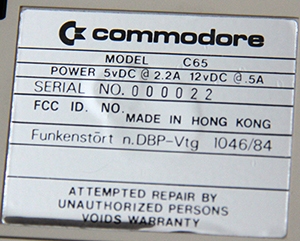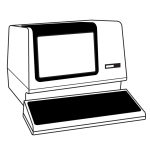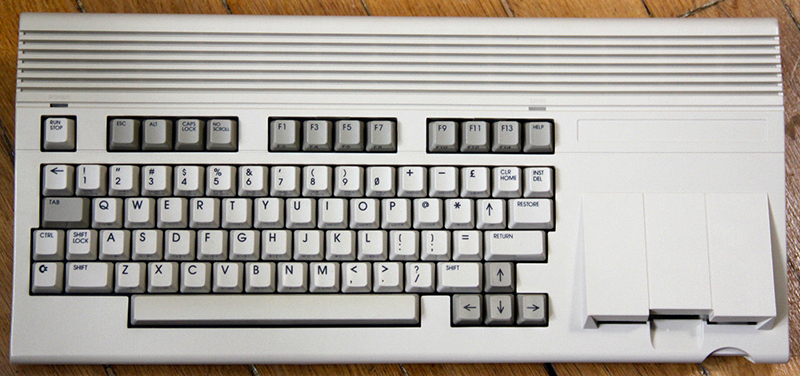This will come to no surprise to anyone who has ever talked to me for more than a few minutes, but one of my guilty Internet pleasures is heading over to eBay’s ‘vintage computing’ category, sorting by highest price, and grabbing a cup of coffee. It’s really just window shopping and after a while you start seeing the same things over and over again; Mac 512s with a starting bid far more than what they’re worth, a bunch of old PC-compatible laptops, and a shocking amount of old software. For the last week I’ve been watching this auction. It’s a Commodore 65 prototype – one of between 50 and 200 that still exist – that has over 60 bids, the highest for over $20,000 USD. It’s the most successful vintage computer auction in recent memory, beating out the usual high-profile auctions like Mac 128s and Altair 8800s. The most valuable home computer is the Apple I, but if you’re wondering what the second most valuable one is, here you go.
 The C65 is not a contemporary of the C64, or even our own [Bil Herd]’s C128. This was the Amiga era, and the C65 was intended to be the last great 8-bit machine. From a page dedicated to the C65, it’s pretty much what you would expect: the CPU is based on a 6502, with the on-die addition of two 6526 CIA I/O controllers. The standard RAM is 128kB, expandable to 8MB by an Amiga 500-like belly port. Sound would be provided by two SIDs, and the video is based on the VIC-III, giving the C65 a pallette of up to 4096 colors and a resolution of up to 1280×400.
The C65 is not a contemporary of the C64, or even our own [Bil Herd]’s C128. This was the Amiga era, and the C65 was intended to be the last great 8-bit machine. From a page dedicated to the C65, it’s pretty much what you would expect: the CPU is based on a 6502, with the on-die addition of two 6526 CIA I/O controllers. The standard RAM is 128kB, expandable to 8MB by an Amiga 500-like belly port. Sound would be provided by two SIDs, and the video is based on the VIC-III, giving the C65 a pallette of up to 4096 colors and a resolution of up to 1280×400.
There’s still a little over five hours to go in the auction, but the current $21000 price should go even higher in the final hour; a C65 auction from a few years ago fetched $20100 for ‘a computer with missing parts’. This auction is for a complete, working system that has remained intact since it was discovered during the Commodore closing.
Update: Auction finished for $22,862.01 USD. For historical purposes, here’s a flickr album, a video, and another video.
 The Hackaday Retro Edition is our celebration of old computers doing something modern, in most cases loading the old, no CSS or Javascript version of our site.
The Hackaday Retro Edition is our celebration of old computers doing something modern, in most cases loading the old, no CSS or Javascript version of our site.
If old and rare computers are your sort of thing, Hackaday will be at the VCF East this year.
If you have an old computer you’d like featured, just load up the retro site, snap some pictures, have them developed, and send them in.
















Damn, now im going to be hooked on the ebay vintage computer lidts and end up buying something absalutely useless but cool.
Did *any* Commodore 900s survive?
These guys have one: http://datamuseum.dk/wiki/Commodore/CBM900
Thanks. Probably should have googled first, but where eyes strike only once, one must quickly choose to go or not go.
I wonder where Commodore’s 900 landfill is.
design started in 1989? Commodore was so mismanaged its not even funny :(
Another pointless pet project like C128 (I had one, what a piece of shit, there was pretty much no c128 soft so you ran it in c64 mode all the time, at twice the price). They were already selling Amiga 500 in 89, and you could go out and buy 386DX 40MHz or first 486s. What were they smoking to come up with 3MHz 8bit computer when market moved on to 16/32 bit? Commodore didnt know what they had when they took over Amiga :( and kept wasting money and R&D on pos like this.
Yep. Pretty much :)
Flame on!
You’re too early, you might run out of popcorn.
You should watch him and see if he does.
I fully agree, what an awful time, the crappy 286/386 graphic & sound, the Atari-Amiga war… which I didn’t care because I had found something way better: ARM
Acorn Archimedes A3000?
yes, (I couldn’t afford the A540). But I’m not from UK, where these computers were common, on the Continent almost nobody did know, that these computer exist.
Yeah, great CPU, would’ve been great if there’d been games for it. By games I mean not shareware. Or “commercial” games made by tiny companies that had the quality of shareware.
While I agree Acorn did make great ARM systems and introduced ARM to consumers. I’ve got a few of those systems ranging from an A3000, 410/1 with CPU/ram upgrade and a few A4000s. The share volume available software for, for example my Zenith Z286LP Plus with its “Brain Dead 286/12 cpu” from 1990 (yes 386SXs where starting to flood the market, 386DXs weren’t being used that much by the average Joe and 486 production was starting to ramp up) with it’s SB card, VGA, HDD and Nic make it quite useful.
I like the fact the Acorn ARM machines had the OS in ROM with the option of booting to the Desktop, Supervisor prompt or Basic as well as read/write PC, Acorn and Atari disks. The add-on expansion podules/mini podules etc are generally plug n play. Some really neat off the wall add-ons for these systems as well. There’s a nice community for these machines. Well that’s the case for the majority of older hardware really.
As for the C65, ok it’s 8-bit but interesting none the less. With only a couple of hundred made between 1989-1991 it’s not surprising the one on ebay went for as much as it did. Commodore made some dumb decisions as did Acorn a bit later on and a number of other computer manufactures.
Ok now where did I put my popcorn?
Yeah you COULD buy a 486 in 1989, for the cost of about 200 Commodores. 8-bit home computers were popular and still being made up til the early 1990s. The 16-bit machines too were expensive. The 8-bits might have lasted a bit longer if they’d have dropped the enormous profit margin somewhat, although they’d largely had their day, as arcade conversions became more and more of a stretch to implement something vaguely alike on aging home hardware.
It’s when the Atari ST and Amiga finally got cheap enough for home purchasers, that they took over the home computer market. PCs were never in the running, with VGA only just coming out and machines costing maybe $1000 for a cheap one. Most PCs of the time were 8086 and 286 with CGA or EGA. Play some old games from then, the PC versions were terrible! The mass market hadn’t kicked in then. And the super-hyper-mass market since Facebook meant people’s mums wanted computers was a long way away.
Commodore already had the Amiga, this machine would have been meant to work with a user’s existing C64 games, which needed back-compatibility. The only options would be a faster 6502, or a 65816, if they existed back then.
how bout an IBM 5100, those are super rare! http://en.wikipedia.org/wiki/IBM_5100
Even with the Titor and Steins;Gate connections, I don’t think you’re going to see an IBM 5100 go for $20k.
The closest you’re going to get to that price range is old, historically important minicomputers. A PDP straight-8, maybe, and possibly an 11/70. Lisp machines, maybe. But those are huge, and we’re talking about ‘home computers’ here.
There’s also a difference between valuing something at a set amount, and selling something for a set amount.
ok, just thought i would mention it as the 5100 is a good looking beast
A PDP for 20k? You sure? I mean they were everywhere where a computer was required. They were the C=64 of their time. I know of several PDP 11 gathering dust in basements, especially the LSI versions. Of course, the ones with the large memory are rare, but valuable? Lisp machines, sure. Xerox Dolphin or Alto are very rare and come expensive. And they even are kind of a personal computer if not a home computer.
For a straight-8, yes. And, I believe a complete PDP-12 went on eBay for more than $16K a while back.
> I know of several PDP 11 gathering dust in basements…
You know we’re opening a hackerspace, right? I’ve come up with a novel central heating solution for southern California: Get a big, rackmount PDP-11, turn it on, and have it run x = x+1 in an infinite loop. Free heating!
Don’t you have gas heating? :P
Better yet, install UNIX or RSTS and use it to host the retro edition. (maybe provide shell accounts too?)
I can’t imagine a lot of demand for an emulated PDP. People don’t use them because the software is better than modern stuff, they use them cos it’s fun to force electrons down ancient pathways, through SSI chips in something the size of a fridge. You could emulate a 14″ disk drive with an SD card but it wouldn’t be any *fun*.
Nearly didn’t mention Der Blinkenlights.
Pls delete my msg above, a brainfart. And this one too. I’ll report them both.
Ahhhh. PDP-8s. 12 bit computing at it’s finest. All the fun times loading the bootstrap through the front panel switches so you could load your programs with paper tape. Ours also had 1K of core memory along with the 8″ floppies. All this reminiscing makes me want to do some FORTRAN 77.
On the commodore F-book page they are saying that it looks like the Ebay seller might have some fake accounts to up the bidding price, this might be a scam.
I am sending this to a buddy of mine. his father had one of those from his work with commodore. I know that he probably tossed it in the trash 2 decades ago, and this article will be an awesome pile of salt and lemon juice in the wound.
You are a cruel man Mr Gray. :-)
Sold for $22,862.01
Wow, I have one of these in the shed and it even has the memory expansion card in it, just haven’t had a power supply to try it with.
I’ll believe it when I see it.
I shall get it out tomorrow and take some pics then :) I was sent it when I was working at The Kremlin which was the Domark in house dev studio, Commodore sent one to us as we were doing cartridges for the their C64 based console at the time. When The Kremlin was moved from Addlestone in Surrey to the Domark offices in Putney there was a massive lear out of old unused hardware and the C65 was put in the skip along with a ton of other bits but I thought it was too interesting to be scrapped so fetched it out before the skip was taken away, but couldn’t find the the power supply. It has a version 2A board in it and the full ram expansion pack.
My name is still on the owners list at http://www.heimcomputer.de/comp/c65.html ‘Chris West’
How big is the memory expansion?
You can use an Amiga CD32 power supply. It’s the same as the C65’s. You should be able to find one on eBay, or just buy a whole CD32 system, these are pretty rare too though :)
Shucks. I would have liked a C65 just for the quirk but I guess I’ll be forever stuck with a mostly working Commodore SuperPET 9000 as the rarest official Commodore product. (waterloo mode works, has security chip still in, standard 8032 mode crashes on power on, no disk drive or IEEE cable to fully test it all)
I bought an Ohio Scientific C1P in 1979 for 500$ (present value 1500$). It had 4K of RAM and Microsoft basic installed. The magazine now called BYTE was titled Kilobaud. It would have lines of code for simple programs that you could install on this primitive computer. I sold it in a year for 250$ because I didn’t want it to become worthless. I have never heard of instant obsolescence before. I keep searching ebay for a listing because I think it would be fun to have it again. I do have an emulator.
http://pastebin.com/iL0L3q6j